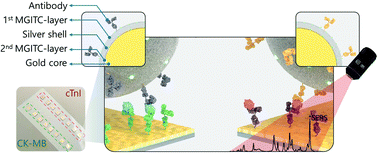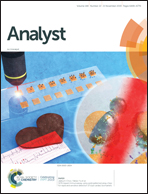SERS-based immunoassay using gold-patterned array chips for rapid and sensitive detection of dual cardiac biomarkers†
Abstract
Cardiac troponin I (cTnI) and creatine kinase-MB (CK-MB) are important diagnostic biomarkers for acute myocardial infarction (AMI). Many efforts have been undertaken to develop highly sensitive detection methods for the quantitative analysis of these dual targets. However, current immunoassay methods are inadequate for accurate measurement of cTnI and CK-MB, due to their limited detection sensitivity. Thus, there is still an urgent demand for a new technique that will enable ultrahigh sensitive detection of these biomarkers. In this study, we developed a surface-enhanced Raman scattering (SERS)-based sandwich immunoassay platform for the ultrasensitive detection of cTnI and CK-MB. In this study, a monoclonal-antibody-immobilized gold-patterned chip was used as a SERS active template. Target samples and polyclonal-antibody-conjugated Au@Ag core–shell nanoparticles were then added. Using this SERS platform, the concentration of biomarkers could be quantified by monitoring the characteristic Raman peak intensity of Raman reporter molecules. Under optimized conditions, the limits of detection (LODs) were estimated to be 8.9 pg mL−1 and 9.7 pg mL−1 for cTnI and CK-MB, respectively. Thus, the proposed SERS-based immunoassay has great potential to be an effective diagnostic tool for the rapid and accurate detection of cTnI and CK-MB.

- This article is part of the themed collection: Bioanalytical tools for enabling precision medicine


 Please wait while we load your content...
Please wait while we load your content...